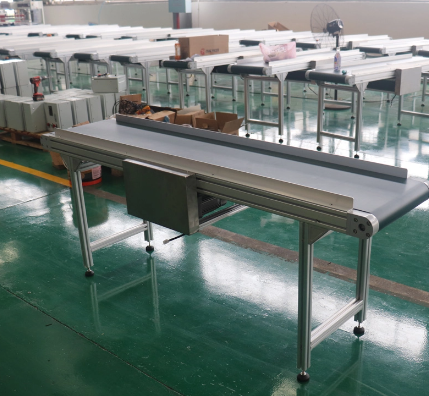
Conveyor systems are a critical component in many industries, facilitating the efficient movement of materials and products across production lines. These systems are widely used in manufacturing, logistics, food processing, and even mining. The choice of materials used in conveyor systems is crucial to their performance, durability, and cost-effectiveness. This paper explores the various materials used in conveyor systems, focusing on their properties, applications, and advantages. We will also examine the growing trend of using aluminum in conveyor systems, particularly in the context of aluminum conveyor systems, which offer significant benefits in terms of weight, corrosion resistance, and ease of customization.
In addition, we will delve into the role of automatic systems, such as the automatic aluminum conveyor, which are increasingly being adopted in industries looking to optimize efficiency and reduce manual labor. Lastly, we will explore the importance of conveyor belts, which are the backbone of any conveyor system, and how different materials used in their construction impact performance.
Materials Commonly Used in Conveyor Systems
1. Steel
Steel is one of the most commonly used materials in conveyor systems due to its strength and durability. It is particularly favored in heavy-duty applications such as mining, construction, and bulk material handling. Steel conveyors can withstand high loads and are resistant to wear and tear. However, steel is prone to corrosion, which can limit its use in environments with high moisture or corrosive chemicals unless treated with protective coatings.
2. Stainless Steel
Stainless steel is an alloy that includes chromium, which provides excellent corrosion resistance. This makes it ideal for use in industries such as food processing, pharmaceuticals, and chemical manufacturing, where hygiene and resistance to corrosive substances are paramount. Stainless steel conveyor systems are also used in environments with extreme temperatures, as the material can withstand both high heat and freezing conditions without degrading.
3. Aluminum
Aluminum is increasingly becoming the material of choice for modern conveyor systems, especially in industries that prioritize lightweight, corrosion-resistant, and easily customizable solutions. Aluminum is significantly lighter than steel, which reduces the overall weight of the conveyor system, making it easier to install and maintain. Additionally, aluminum's natural resistance to corrosion makes it ideal for use in environments where moisture or chemicals are present.
One of the key advantages of aluminum is its versatility. It can be easily extruded into various shapes and sizes, allowing for the creation of highly customized conveyor systems. Companies such as aluminum extrusion manufacturers play a crucial role in providing the raw materials needed for these systems. Aluminum conveyor systems are also compatible with automation technologies, making them a popular choice for industries looking to implement smart manufacturing solutions.
4. Plastic
Plastic materials, such as polyethylene and polypropylene, are commonly used in conveyor systems that handle lightweight products. These materials are highly resistant to corrosion and chemicals, making them ideal for use in industries such as food processing and pharmaceuticals. Plastic conveyors are also quieter and require less maintenance than their metal counterparts. However, they are not suitable for heavy-duty applications due to their lower strength and durability.
5. Rubber
Rubber is primarily used in the construction of conveyor belts. It offers excellent grip and flexibility, making it ideal for moving products along inclines or declines. Rubber belts are also resistant to abrasion, which extends their lifespan in high-wear environments. However, rubber can degrade when exposed to extreme temperatures or harsh chemicals, so it is often combined with other materials to improve its performance in specific applications.
The Role of Conveyor Belts
Conveyor belts are the most critical component of any conveyor system. They are responsible for carrying the load and ensuring smooth and efficient material handling. Conveyor belts are typically made from a combination of materials, including rubber, fabric, and metal. The choice of material depends on the specific requirements of the application, such as load capacity, speed, and environmental conditions.
For instance, conveyor belts used in food processing must be made from materials that are resistant to moisture and easy to clean, such as food-grade rubber or plastic. In contrast, conveyor belts used in mining or bulk material handling need to be highly durable and resistant to abrasion. The design and material of the belt can significantly impact the performance and longevity of the conveyor system.
In recent years, there has been a growing trend toward using modular conveyor belts, which are made from interlocking plastic segments. These belts are highly customizable and can be easily replaced or repaired, reducing downtime and maintenance costs. Additionally, modular belts are compatible with automation technologies, making them ideal for use in automatic aluminum conveyor systems.
Advantages of Aluminum in Conveyor Systems
1. Lightweight
One of the most significant advantages of aluminum is its lightweight nature. This makes aluminum conveyor systems easier to install and move, reducing labor costs and installation time. The reduced weight also means that less energy is required to operate the system, leading to lower operational costs.
2. Corrosion Resistance
Aluminum is naturally resistant to corrosion, making it an excellent choice for conveyor systems used in environments where moisture or chemicals are present. This property extends the lifespan of the system and reduces the need for frequent maintenance or replacement of parts. Industries such as food processing, pharmaceuticals, and chemical manufacturing benefit greatly from aluminum's corrosion resistance.
3. Customizability
Aluminum is highly versatile and can be easily extruded into various shapes and sizes. This allows for the creation of highly customized conveyor systems that can be tailored to the specific needs of the application. Companies specializing in aluminum extrusion manufacturing provide the raw materials needed to build these systems, ensuring that they meet the exact specifications of the client.
In conclusion, the choice of material in conveyor systems plays a critical role in determining their performance, durability, and cost-effectiveness. While steel and stainless steel are commonly used for heavy-duty applications, aluminum is emerging as a popular choice for industries that prioritize lightweight, corrosion-resistant, and customizable solutions. The use of aluminum conveyor systems offers significant advantages, including reduced weight, lower operational costs, and increased flexibility in design.
As industries continue to adopt automation technologies, the demand for materials that are compatible with smart manufacturing solutions will only increase. Aluminum, with its versatility and ease of customization, is well-positioned to meet these demands, particularly in the context of automatic aluminum conveyor systems. Ultimately, the choice of material should be guided by the specific requirements of the application, ensuring that the conveyor system delivers optimal performance and longevity.









